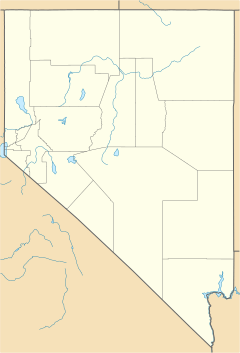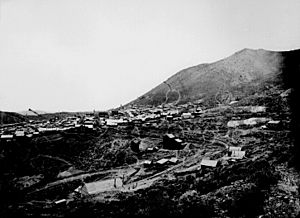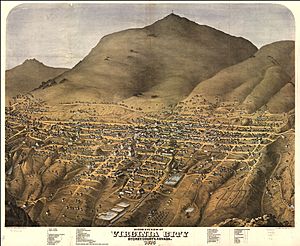Virginia City, Nevada facts for kids
Quick facts for kids
Virginia City, Nevada
|
|
|---|---|
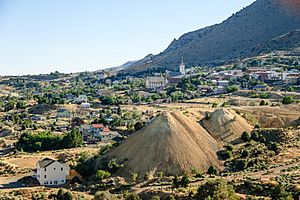
View of Virginia City, July 2016
|
|
| Nickname(s):
The Richest Place on Earth
|
|
| Motto(s):
"Step Back in Time"
|
|
| Country | United States |
| State | Nevada |
| County | Storey |
| Area | |
| • Total | 0.87 sq mi (2.24 km2) |
| • Land | 0.87 sq mi (2.24 km2) |
| • Water | 0.00 sq mi (0.00 km2) |
| Elevation | 6,106 ft (1,861 m) |
| Population
(2020)
|
|
| • Total | 787 |
| • Density | 907.73/sq mi (350.60/km2) |
| Time zone | UTC−8 (Pacific (PST)) |
| • Summer (DST) | UTC−7 (PDT) |
| ZIP Code |
89440
|
| FIPS code | 32-80000 |
| GNIS feature ID | 2629981 |
Virginia City is a special kind of town called a census-designated place (CDP). It is the main town, or county seat, of Storey County, Nevada. It is also the biggest community in that county. This historic city is part of the larger Reno–Sparks area.
Virginia City grew very quickly, becoming a "boomtown," after a huge discovery in 1859. This was the Comstock Lode, the first major silver deposit found in the United States. Many mines opened because of it. The town's population was largest in the mid-1870s, with about 25,000 people living there. After 1878, the mines produced less silver, and the population went down. In the 2020 Census, Virginia City had 787 residents.
Contents
History of Virginia City
The discovery of the Comstock Lode is often credited to Peter O'Riley and Patrick McLaughlin. However, Henry T. P. Comstock made sure his name was linked to it. A popular story says that James Fennimore, also known as Old Virginny Finney, named the town. He supposedly tripped and broke a bottle at a saloon in Gold Hill, which later became Virginia City.
Another story says that the Ophir Diggings were named for Finney because he was one of the first to find minerals there. He was also known as a very successful prospector. Finney was considered the best at finding placer ground in Gold Canyon. He found the quartz footwall of the Ophir in 1858 and other valuable spots in 1857 and 1859.
After the Comstock Lode was found in 1859, Virginia City appeared almost overnight. It was built on the eastern slopes of Mount Davidson, high up at 6,200 feet. Deep tunnels and shafts for silver mining were dug beneath the town. The discovery of the Comstock Lode and Virginia City's quick growth were unique compared to other metal discoveries.
Virginia City's silver discoveries were different from the California Gold Rush, which happened 10 years earlier. When the Comstock Lode was found, silver was considered as valuable as gold. The government bought all the silver produced to make coins. In 1873, the government stopped using silver for coins. This was partly because so much silver from Virginia City's mines entered the world markets.
Mining Technology and Wealth
Early mining faced many problems. New technologies were needed to handle the challenges. A German engineer named Philip Deidesheimer created a system called "square sets." This system used timber to support mining tunnels safely. It allowed miners to get huge amounts of silver ore.
Many other inventions helped the mines. These included roots blowers, stamp mills, the Washoe Pan milling process, and Cornish pumps. Also, Burleigh machine drills, wire woven rope, and safety cages for miners were developed. Even the Sutro Tunnel was built to help the mines. These new technologies were later used in many other mining projects.
By 1876, Virginia City was a busy place. One person said that "every activity has to do with the mining, transportation, or reduction of silver ore." Nevada produced over half of all precious metals in the United States by 1876. The Comstock Lode produced silver and gold worth hundreds of thousands of dollars each year. This wealth helped the Northern side during the American Civil War. It also affected money markets worldwide.
Virginia City was a mining boomtown, like many towns in Nevada. It grew very fast after the 1859 silver strike. But Virginia City was special because of its large population and new technologies. Its growth helped Nevada become a state. The wealth from the Comstock Lode encouraged people to look for silver mines all over Nevada and the American West.
Virginia City's population grew from 4,000 in 1862 to over 15,000 in 1863. The number of people changed often, depending on how much ore the mines produced. The city quickly became one of the largest in the American Southwest. By 1880, Virginia City was even bigger than some major US cities today, like Phoenix or Dallas.
The city had gas and sewer lines. It also had the 100-room International Hotel with an elevator, three theaters, and the Maguire Opera House. There were four churches and three daily newspapers. Many homes and buildings were made of brick.
Because of its wealth, many important leaders and business people came from Virginia City. After the "Big Bonanza" of 1873, the city had over 25,000 residents. It was called the richest city in the United States. Money from San Francisco greatly influenced Virginia City. People often said, "San Francisco on the coast and Virginia City inland." Many early settlers in Virginia City had come from San Francisco after the California Gold Rush.
A stock market in San Francisco was created just for Comstock mining. The Bank of California used money from the Comstock mines to build San Francisco's financial district. The success of the Comstock Lode helped San Francisco grow from a small town. "Almost all the profits from the Comstock were invested in San Francisco." So, Virginia City helped build San Francisco. The Comstock's success was worth about $400 million in that time. Mining and the people it attracted led to Nevada becoming a separate territory and later a state.
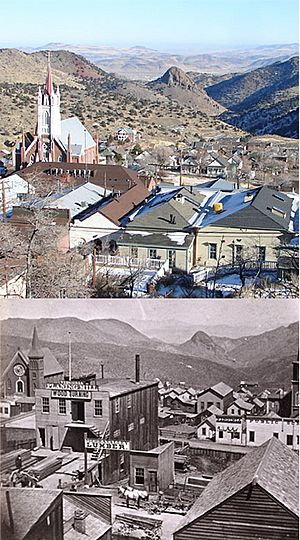
Virginia City was an industrial center, like those on the East Coast, because of its mining industry. But it still felt like a frontier town. Many immigrants lived there. Miners from Cornwall, England, who knew about hard rock mining, came to the Comstock. These English immigrants were one of the largest groups. Many miners were also Irish. In 1870, Asians made up 7.6% of the population. These were mainly Chinese workers who settled in western towns after building the transcontinental railroad. Chinese workers often filled jobs like laundry workers and cooks.
Over time, many independent Comstock mines were bought by large companies. A group called the Bank Crowd, led by William Sharon in Virginia City and William Ralston in San Francisco, controlled the mines and mills. They made fortunes by controlling stock prices. When it seemed the Comstock Lode was running out, the city's population dropped sharply. Ten thousand people left in 1864 and 1865.
By the late 1860s, a group of Irish investors challenged the Bank Crowd. John Mackay and his partner James Fair started as regular miners. They worked their way up to management. By buying mine stock, they became financially independent. Their partners, James Clair Flood and William S. O'Brien, stayed in San Francisco and traded stocks. These four men, called the Irish Big Four or Bonanza Kings, eventually controlled the Consolidated Virginia mine. This is where the "Big Bonanza" was found in 1873. The next few years were the most profitable for the Comstock. The Irish Big Four took control from the Bank Crowd. The population reached 25,000 in 1875.
Mining was difficult because of the very hot temperatures in the mines. These were caused by natural hot springs. In winter, miners would snowshoe to the mines, then go down to work in extreme heat. These tough conditions led to a shorter life expectancy for miners. They were even called "Hot Water Plugs." Adolph Sutro built the Sutro Tunnel to drain the hot water. But by the time it was finished in 1879, the mines had been dug much deeper. In 1879, the mines started to produce less, and the population dropped to under 11,000.
The Great Fire of 1875
Between 1859 and 1875, Virginia City had many serious fires. The fire on October 26, 1875, was called the Great Fire. It caused $12 million in damage. People said it looked like "the world was on fire." Even though some mine buildings burned, the fire did not go deep into the mine shafts. Railroad car wheels melted, and brick buildings fell like paper boxes. Two thousand people lost their homes.
The city was rebuilt in the months that followed. Most of the buildings in the National Historic Landmark historic district today are from this time. However, the period of great wealth, the "bonanza," ended by 1880.
Virginia City and Mark Twain
| Historical population | |||
|---|---|---|---|
| Census | Pop. | %± | |
| 1860 | 2,345 | — | |
| 1870 | 7,048 | 200.6% | |
| 1880 | 10,917 | 54.9% | |
| 1890 | 8,511 | −22.0% | |
| 1900 | 2,695 | −68.3% | |
| 1910 | 2,244 | −16.7% | |
| 1920 | 1,200 | −46.5% | |
| 1930 | 590 | −50.8% | |
| 1940 | 500 | −15.3% | |
| 1950 | 500 | 0.0% | |
| 1960 | 610 | 22.0% | |
| 1970 | 600 | −1.6% | |
| 1980 | 600 | 0.0% | |
| 1990 | 920 | 53.3% | |
| 2000 | 771 | −16.2% | |
| 2010 | 855 | 10.9% | |
| 2020 | 787 | −8.0% | |
| source: | |||
The famous writer and humorist Samuel Clemens first used his pen name Mark Twain in Virginia City. This was in February 1863. Clemens was a reporter for the local Territorial Enterprise newspaper. He lived in Virginia City and wrote for the Enterprise from late 1862 to May 1864. He left to avoid a duel with another newspaper editor who was unhappy with his reporting.
Clemens returned to the Comstock region twice for lecture tours. In 1866, he was involved in a practical joke where friends pretended to rob him. He did not like the joke but got his valuable gold watch back. Clemens' book Roughing It (1872) tells this story and other tales about the city. His second return was in 1868.
Climate in Virginia City
Virginia City has a hot-summer mediterranean climate (Csa). This means it has warm to hot summers and cooler, rainier winters.
| Climate data for Virginia City, Nevada, 1991–2020 normals, extremes 1887–present | |||||||||||||
|---|---|---|---|---|---|---|---|---|---|---|---|---|---|
| Month | Jan | Feb | Mar | Apr | May | Jun | Jul | Aug | Sep | Oct | Nov | Dec | Year |
| Record high °F (°C) | 69 (21) |
70 (21) |
74 (23) |
79 (26) |
89 (32) |
95 (35) |
99 (37) |
100 (38) |
93 (34) |
85 (29) |
75 (24) |
69 (21) |
100 (38) |
| Mean maximum °F (°C) | 55.3 (12.9) |
57.1 (13.9) |
64.6 (18.1) |
71.8 (22.1) |
80.0 (26.7) |
87.3 (30.7) |
93.3 (34.1) |
91.0 (32.8) |
86.2 (30.1) |
77.6 (25.3) |
64.6 (18.1) |
56.0 (13.3) |
93.8 (34.3) |
| Mean daily maximum °F (°C) | 40.9 (4.9) |
43.1 (6.2) |
49.0 (9.4) |
54.6 (12.6) |
63.9 (17.7) |
74.3 (23.5) |
83.8 (28.8) |
82.4 (28.0) |
73.9 (23.3) |
61.3 (16.3) |
48.8 (9.3) |
40.3 (4.6) |
59.7 (15.4) |
| Daily mean °F (°C) | 33.9 (1.1) |
35.9 (2.2) |
40.9 (4.9) |
45.2 (7.3) |
53.9 (12.2) |
63.5 (17.5) |
72.6 (22.6) |
71.2 (21.8) |
63.5 (17.5) |
51.9 (11.1) |
40.8 (4.9) |
33.4 (0.8) |
50.6 (10.3) |
| Mean daily minimum °F (°C) | 27.0 (−2.8) |
28.6 (−1.9) |
32.9 (0.5) |
35.7 (2.1) |
44.0 (6.7) |
52.8 (11.6) |
61.5 (16.4) |
60.1 (15.6) |
53.1 (11.7) |
42.5 (5.8) |
32.7 (0.4) |
26.4 (−3.1) |
41.4 (5.3) |
| Mean minimum °F (°C) | 12.3 (−10.9) |
15.0 (−9.4) |
18.9 (−7.3) |
22.6 (−5.2) |
29.7 (−1.3) |
35.8 (2.1) |
50.5 (10.3) |
49.1 (9.5) |
37.8 (3.2) |
26.3 (−3.2) |
17.4 (−8.1) |
11.8 (−11.2) |
8.1 (−13.3) |
| Record low °F (°C) | −1 (−18) |
−9 (−23) |
4 (−16) |
10 (−12) |
15 (−9) |
28 (−2) |
36 (2) |
31 (−1) |
21 (−6) |
11 (−12) |
6 (−14) |
−11 (−24) |
−11 (−24) |
| Average precipitation inches (mm) | 1.82 (46) |
2.06 (52) |
1.60 (41) |
0.54 (14) |
0.74 (19) |
0.55 (14) |
0.19 (4.8) |
0.24 (6.1) |
0.29 (7.4) |
0.65 (17) |
1.07 (27) |
1.95 (50) |
11.70 (297) |
| Average snowfall inches (cm) | 13.0 (33) |
8.7 (22) |
9.3 (24) |
2.3 (5.8) |
0.7 (1.8) |
0.2 (0.51) |
0.0 (0.0) |
0.0 (0.0) |
0.0 (0.0) |
0.3 (0.76) |
2.4 (6.1) |
9.5 (24) |
46.4 (117.97) |
| Average precipitation days (≥ 0.01 in) | 5.7 | 5.5 | 4.4 | 2.5 | 3.2 | 2.0 | 1.0 | 1.1 | 1.3 | 2.0 | 3.4 | 4.7 | 36.8 |
| Average snowy days (≥ 0.1 in) | 4.0 | 3.9 | 2.7 | 1.1 | 0.4 | 0.1 | 0.0 | 0.0 | 0.1 | 0.1 | 1.5 | 3.9 | 17.8 |
| Source 1: NOAA | |||||||||||||
| Source 2: National Weather Service | |||||||||||||
Economy and Tourism

Today, Virginia City's economy relies on tourism. Many people who live there own or work in shops that serve visitors. Others find jobs in nearby cities. Virginia City is a National Historic Landmark District, which means it's a very important historic place. It attracts over 2 million visitors each year. Many of its historic buildings are also listed on the National Register of Historic Places.
Tourism supports many different restaurants, from fancy to casual. There are also many places for tourists to stay overnight. Several bed and breakfast inns are in old, restored homes. These include the B Street House Bed and Breakfast, the Henry Piper House, Edith Palmer's Country Inn, and the 1876 Cobb Mansion.
Arts and Culture
Virginia City has many museums and historic sites to explore. These include the Silver Terrace Cemetery, the Fourth Ward School Museum, and the Pioneer Cemetery. You can also visit the Fireman's Museum, the Way It Was Museum, and Piper's Opera House. There's also the Police Officer's Museum and St. Mary's Art Center. Many businesses around town also have exhibits. Virginia City hosts unique events like cook-offs, parades, and Civil War re-enactments.
Virginia City Hillclimb Race
Every year, there's a car race called a hillclimb. It goes from Silver City to Virginia City on Highway 341. This event is put on by the Ferrari Club of America Pacific Region and the Northern California Shelby Club. Since 2013, all types of performance cars can join.
The event was first started by Road & Track magazine and the Aston Martin Club. Later, the SCCA used the same route, and then the Ferrari Owners Club took it over. Highway 342 is now used for cars returning after their race up Highway 341. The hillclimb race covers about 5.2 miles (8.4 km). Cars climb 1,260 feet (384 m) and go through 21 turns.
Museums and Historic Places
Virginia City has kept its old-time feel with wooden sidewalks and many restored buildings from the 1860s and 1870s. The Fourth Ward School Museum brings the Comstock history to life with interactive displays. It also has a restored classroom from 1876. This four-story wooden school is the last of its kind in the United States.
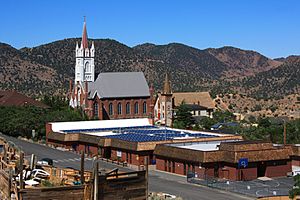
Other interesting places include the Comstock Historic Walking Trail. Here, you can see the Pioneer Cemetery, where Julia Bulette is buried. You can also see the Combination Mine Shaft and Sugarloaf Mountain. Other attractions are the Silver State Police Officers' Museum in the Storey County Courthouse, with jail cells from the 1870s. There's also The Way It Was museum, the Fireman's Museum with old firefighting equipment, and tours of the Chollar Mine and Ponderosa Mine.
You can visit the Silver Terrace Cemetery, the Presbyterian Church (built 1862), and St. Mary's of the Mountain Catholic Church (around 1876). Also, there's St. Paul's Episcopal Church and St. Mary's Art Center, which offers art classes. You can take trolley tours or walking tours. Other sights include the Storey County Courthouse, Miner's Union Hall, Knights of Pythias Building, and many historic shops and homes. The Old Washoe Club and Miner's Park are also popular.
The Red Dog Saloon helped many San Francisco rock musicians get their start in the summer of 1965. Piper's Opera House is on the corner of B and Union Streets. It is open as a museum when it's not hosting shows and music events. Piper's Corner Saloon was one of the oldest saloons that stayed open continuously in the 1800s.
The historic Union Brewery and saloon, built in 1864, is at 28 North C Street. Mark Twain used to visit it. It has been restored and is now open again.
Virginia City also has the Silver Queen Hotel and Wedding Chapel. It is famous for a picture of a woman whose dress is made entirely of silver dollars. The hotel was built in 1876 and has a saloon.
Virginia City was named a National Historic Landmark district in 1961. It has been carefully kept to preserve its historic look.
Education in Virginia City
Virginia City has schools for different age groups. There is one elementary school (Hugh Gallagher Elementary School), one middle school (Virginia City Middle School), and one high school (Virginia City High School).
Transportation and Infrastructure
Virginia and Truckee Railroad
The Virginia and Truckee Railroad starts in Virginia City. A project began in 1972 to rebuild this historic railroad, known as one of the nation's "crookedest railroads." The rebuilt part of the line goes south to Carson City and through Gold Hill. The first steam engine ran from Carson City on September 5, 2009. Now, the railroad offers tourist trips between Carson City and Virginia City on weekends. On weekdays, other trains pulled by old locomotives offer 35-minute round trips between Virginia City and Gold Hill.
Notable People from Virginia City
Many interesting people have connections to Virginia City:
- Fred B. Balzar: The 15th Governor of Nevada from 1927 to 1934; he was born in Virginia City.
- Lucius Beebe: An author and historian who wrote about railroads.
- Charles Clegg: An author, photographer, and railroad historian.
- Dan DeQuille: An author, journalist, and humorist.
- James Graham Fair: A mine owner and partner to John Mackay.
- George Hearst: An early manager of the Gould and Curry mine in 1860.
- Harold A. Henry: President of the Los Angeles City Council; he was born in Virginia City.
- John Brayshaw Kaye: A poet and politician who worked in the town in the 1800s.
- Richard Kirman Sr.: The 17th Governor of Nevada from 1935 to 1939; he was born in Virginia City.
- Ezra F. Kysor: An architect who worked in Virginia City from 1865 to 1868.
- John William Mackay: The wealthiest mining millionaire from the Comstock Lode.
- Albert A. Michelson: The first American to win the Nobel Prize in Physics (1907); he grew up in Virginia City.
- Ferdinand Schulze: A Prussian immigrant who became a member of the Wisconsin State Assembly.
- W. H. C. Stephenson: An early African American figure who supported voting rights for Black people.
- W. Frank Stewart: A silver mine operator and Nevada state senator from 1876 to 1880.
- Marie Suize: A Frenchwoman who ran a shop selling wines and liquors.
- Adolph Sutro: An industrialist and later mayor of San Francisco.
- "Professor" Jerry Thomas: A famous bartender.
- Mark Twain: Worked for the local newspaper; his novel Roughing It is set in and around Virginia City.
|
See also
 In Spanish: Virginia City (Nevada) para niños
In Spanish: Virginia City (Nevada) para niños


